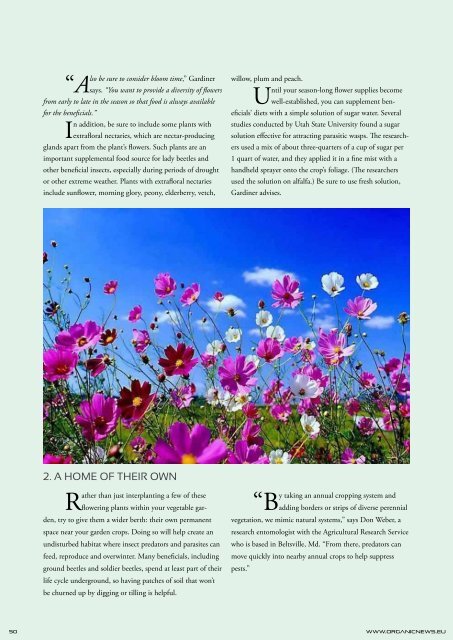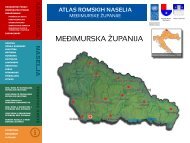Organic News 3
Organic News magazine issue 3
Organic News magazine issue 3
You also want an ePaper? Increase the reach of your titles
YUMPU automatically turns print PDFs into web optimized ePapers that Google loves.
lso be sure to consider bloom time,” Gardiner<br />
“Asays. “You want to provide a diversity of flowers<br />
from early to late in the season so that food is always available<br />
for the beneficials.”<br />
In addition, be sure to include some plants with<br />
extrafloral nectaries, which are nectar-producing<br />
glands apart from the plant’s flowers. Such plants are an<br />
important supplemental food source for lady beetles and<br />
other beneficial insects, especially during periods of drought<br />
or other extreme weather. Plants with extrafloral nectaries<br />
include sunflower, morning glory, peony, elderberry, vetch,<br />
willow, plum and peach.<br />
Until your season-long flower supplies become<br />
well-established, you can supplement beneficials’<br />
diets with a simple solution of sugar water. Several<br />
studies conducted by Utah State University found a sugar<br />
solution effective for attracting parasitic wasps. The researchers<br />
used a mix of about three-quarters of a cup of sugar per<br />
1 quart of water, and they applied it in a fine mist with a<br />
handheld sprayer onto the crop’s foliage. (The researchers<br />
used the solution on alfalfa.) Be sure to use fresh solution,<br />
Gardiner advises.<br />
2. A HOME OF THEIR OWN<br />
Rather than just interplanting a few of these<br />
flowering plants within your vegetable garden,<br />
try to give them a wider berth: their own permanent<br />
space near your garden crops. Doing so will help create an<br />
undisturbed habitat where insect predators and parasites can<br />
feed, reproduce and overwinter. Many beneficials, including<br />
ground beetles and soldier beetles, spend at least part of their<br />
life cycle underground, so having patches of soil that won’t<br />
be churned up by digging or tilling is helpful.<br />
y taking an annual cropping system and<br />
“Badding borders or strips of diverse perennial<br />
vegetation, we mimic natural systems,” says Don Weber, a<br />
research entomologist with the Agricultural Research Service<br />
who is based in Beltsville, Md. “From there, predators can<br />
move quickly into nearby annual crops to help suppress<br />
pests.”<br />
50<br />
WWW.ORGANICNEWS.EU






